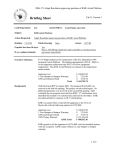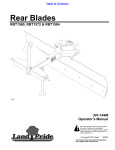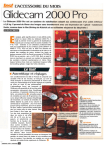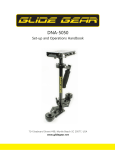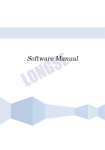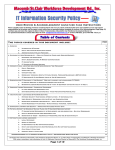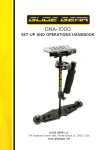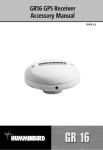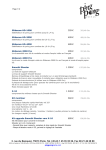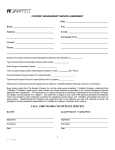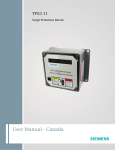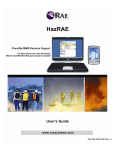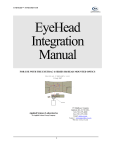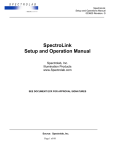Download Glidecam 4000
Transcript
table of contents SECTION # PAGE # 1. Introduction 3 2. Glidecam 2000 Pro Parts and Components 4 3. Assembling your Glidecam 2000 Pro 8 4. Attaching your camera to your Glidecam 17 5. Balancing your Glidecam 2000 Pro 20 6. Handling your Glidecam 2000 Pro 25 7. Operating your Glidecam 2000 Pro 26 8. Shooting Tips 28 9. Improper Techniques 29 10. Other Camera attachment methods 30 11. Professional usage 30 12. Maintenance 31 13. Warnings 31 14. Warranty 32 1 2 PLEASE NOTE Since the Glidecam 2000 Pro and the Glidecam 4000 Pro are basically the same, this manual only shows photographs of the Glidecam 2000 Pro being setup and used. The Glidecam 4000 Pro is just a bigger and stronger version of the 2000 Pro. When there is an important difference between the two products you will see it noted with a ***. Also, the words 2000 Pro will be used for the most part to mean both the 2000 Pro and the 4000 Pro. #1 INTRODUCTION Congratulations on your purchase of a Glidecam 2000 Pro, and/or Glidecam 4000 Pro. The Glidecam 2000 Pro is a lightweight, aluminum, hand-held camcorder stabilizing system designed to allow you to walk, run, go up and down stairs and travel over rugged terrain without any camera instability or shake. When used correctly the Glidecam 2000 Pro can move with such fluidity and grace as to be virtually indistinguishable from shots made by expensive dollies, cranes and stabilizers. The Glidecam 2000 Pro is the most versatile and dynamic of all the consumer camcorder stabilizers on the market. It can shoot straight up and down, or even sideways and still produce stable images. Fluid tilts and pans, crane-like booms, dolly-type maneuvers, and the ability to shoot smooth shots from moving vehicles are all easily accomplished with the Glidecam 2000 Pro. The offset gimbaled handle-grip and enclosed bearing assembly allow your hand to move freely in several directions, while the horizontal yoke allows your hand and arm to move up and down, alleviating the bouncing, pogo-type action often associated with our competitors’ systems. The upper camera platform moves back and forth, and side to side to quickly allow the balancing of your camera in relationship to the counterweights. By varying the amount of counterweight disks on the base platform, the Glidecam 2000 Pro can support any compact, camcorder weighing up to six pounds, and the *** Glidecam 4000 Pro can support any camcorder weighing from four to ten pounds. The Glidecam 2000 Pro requires practice and understanding to achieve professional looking results. We highly recommend that the user read this manual thoroughly before setting up and operating the Glidecam 2000 Pro. Doing so will save you time, and will minimize the risk of damage to your camera, camcorder or the Glidecam 2000 Pro. It is important to perform and follow the Set-up and Operation’s procedures in the proper sequence, so as to avoid both frustration and a possible accident. If you have need of any technical assistance, you can call our Technical Support Line at 1-508-830-1414, Monday through Friday between the hours of 9:00 AM and 5:00 PM, Eastern Time, USA. We are sure that once you have your Glidecam 2000 Pro set-up and running, you will find years of enjoyment with it. 3 #2 - GLIDECAM 2000 PRO PARTS AND COMPONENTS 1 Congratulations on your purchase of a Glidecam 2000 Pro. When you unpack your Glidecam 2000 Pro you will see that it is not completely assembled. Contents of the Glidecam 2000 Pro shipping box include; the MANUAL, CENTRAL POST with gimbal assembly, HEAD PLATE, MID PLATE, BOTTOM PLATE, BASE PLATFORM, TELESCOPING POST, HARDWARE bag, and COUNTER WEIGHT DISKS. TOOLS NEEDED: You will need both Standard and Phillips Head Screwdrivers (not included). 2 GIMBAL ASSEMBLY This is the Glidecam 2000 Pro CENTRAL POST with attached gimbal assembly. *** The Glidecam 4000 Pro has a longer CENTRAL POST. Warning – Do not adjust or tighten the factory settings on the gimbal, handle, and yoke. These parts should remain loose and move freely, just as they are shipped to you. TELESCOPING CLAMP 3 These are the pieces that makeup the HEAD ASSEMBLY of the Glidecam 2000 Pro. 1) HEAD PLATE (shown left) 2) MID PLATE (shown center) 3) BOTTOM PLATE (shown right) 4 4 This is the HEAD PLATE for the Glidecam 2000 Pro. This is the plate that you’ll be mounting your Camera on. *** The HEAD PLATE for the Glidecam 4000 Pro is different than the one shown to the left. The 4000 Pro HEAD PLATE has 3/8” and 1/4” mounting holes. 5 This is the MID PLATE. 6 This is the BOTTOM PLATE. 5 7 This is the BASE PLATFORM. *** The Glidecam 4000 Pro has a larger BASE PLATFORM. 8 This is the TELESCOPING POST. 9 These are the 14 COUNTER WEIGHT DISKS. (shown in bag) *** The Glidecam 4000 Pro has 20 COUNTER WEIGHT DISKS. 6 This is the HARDWARE set for the Glideacm 2000 Pro. 10 (shown in bag in Photo #10) (shown in full in Photo #11) *** The Glidecam 4000 Pro has slightly different HARDWARE. More weight disks are provided, as well as 3/8” MOUNTING SCREWS and some 3/8” WASHERS. 11 7 #3 ñ Assembling your Glidecam 2000 Pro 12 First, Get the BASE PLATFORM and the TELESCOPING POST. See photo #7 & #12 for the BASE PLATFORM & photo #8 & #13 for the TELESCOPING POST. 13 Note the threaded insert located in the bottom of the TELESCOPING POST. 8 14 Connect the TELESCOPING POST to the BASE PLATFORM by tightly screwing the TELESCOPING POST onto the threaded stud sticking up from the center of the BASE PLATFORM. 15 At this point your Glidecam 2000 Pro should look like photo #15 which is with the TELESCOPING POST attached to the BASE PLATFORM securely. 9 Now find a pair of bolts (example: ¼” x 20 x 1") and attach RUBBER WASHERS as shown in the photo to the left. 16 NOTE: Different length bolts are provided so you can use the longer bolts for a taller stack of COUNTER WEIGHT DISKS. 17 Now, insert the selected bolts with RUBBER WASHERS attached through the slots in the BASE PLATFORM as shown in this picture and repeat this procedure for the slot on the other side of the BASE PLATFORM. 18 At this point your Glidecam 2000 Pro should look like this photo. NOTE: This is the Monitor Mounting Hole 10 19 Stack COUNTER WEIGHT DISKS and center them over the bolts on the BASE PLATFORM as shown in this photo. NOTE: Different length bolts are provided so you can use the longer bolts for a taller stack of COUNTER WEIGHT DISKS. NOTE: Heavy Cameras require more COUNTER WEIGHT DISKS than do light Cameras. 20 Place the two FENDER WASHERS over the COUNTER WEIGHT DISKS stacks as shown. 21 Secure the COUNTER WEIGHT DISKS with the BRASS THUMB NUTS as shown in this photo and repeat this procedure for the COUNTER WEIGHT DISKS on the other side of the BASE PLATFORM. 11 22 Both COUNTER WEIGHT DISK stacks should now be secured in place with the FENDER WASHERS and BRASS THUMB NUTS as shown in this photo. 23 Monitor Mounting Hole should be in front. Telescoping Clamp’s “Adjustment Knob” shown aligned incorrectly. Telescoping Clamp’s Adjustment Knob should be in back. 24 Telescoping Clamp’s “Adjustment Knob” shown aligned correctly. 12 Now, insert the TELESCOPING POST with the attached BASE PLATFORM Assembly up and into the CENTRAL POST (the Central Post can be seen in photo # 2). The TELESCOPING CLAMP’S “Adjustment Knob” should be facing the back end of the BASE PLATFORM, opposite the Monitor Mounting Hole. The Monitor Mounting Hole should be in the front of the BASE PLATFORM. The TELESCOPING CLAMP’S “Adjustment Knob” should be aligned so that it look like it does in photo # 24. To align the TELESCOPING CLAMP’S “Adjustment Knob” simply rotate the entire CENTRAL POST into the correct position, and then tighten the “Adjustment Knob”. Also leave about 1 inch of TELESCOPING POST showing below the TELESCOPING CLAMP. Also, having the TELESCOPING CLAMP’S “Adjustment Knob” aligned correctly, while not technically needed to make your Glidecam 2000 Pro function correctly, does make it easier to reach the Knob later when you use it. 25 Securely tighten the “Adjustment Knob” on the TELESCOPING CLAMP by rotating the Knob clockwise as shown in this photo. The “Adjustment Knob” should only be hand tightened. WARNING: DO NOT OVERTIGHTEN THIS KNOB. 26 At this point this is what your 2000 Pro should look like, which is with the CENTRAL POST and TELESCOPING CLAMP aligned correctly on the TELESCOPING POST and BASE PLATFORM assembly. The amount of COUNTER WEIGHT DISKS will vary depending on your Camera weight. Don’t worry about this too much, for later you will set the number of COUNTER WEIGHT DISKS to the correct amount required for your specific Camera. 13 27 This is a photo of the THREADED INSERT in the top of the CENTRAL POST. 28 Rotate and screw the BOTTOM PLATE into the THREADED INSERT in the top of the CENTRAL POST. 29 Tighten the BOTTOM PLATE to the top of CENTRAL POST to ensure a tight fit. 14 29A In the next procedure you are going to align the BOTTOM PLATE so that its front edge is parallel to the front edge of the BASE PLATFORM. The result of this correct alignment will make your Glidecam 2000 Pro look like Photo 29B and Photo 29C. Photo 29C is taken from the point of view of looking straight down at the front of the Glidecam 2000 Pro. There are two ways to create this correct alignment. The first and easiest is to just loosen the “Adjustment Knob” on the TELESCOPING CLAMP and then rotate the parts until they are correctly aligned as in Photos 29B and 29C. Then simply retighten the “Adjustment Knob”. Remember to leave about 1 inch of TELESCOPING POST showing below the TELESCOPING CLAMP as before. The second way to correctly align the parts (see Photo 29A) is to use a Phillips Screwdriver to loosen the “Screw” on the top part of the TELESCOPING CLAMP until you can rotate the parts so they are correctly aligned as in Photos 29B and 29C. Then simply retighten the “Screw”. 29B NOTE: The second method of alignment is better because it keeps the TELESCOPING CLAMP’S “Adjustment Knob” aligned correctly as previously shown in Photo 24, and having the TELESCOPING CLAMP’S “Adjustment Knob” aligned correctly, while not technically needed to make your Glidecam 2000 Pro function correctly, does make it easier to reach the Knob later when you use it. 29C 15 30 Now place the MID PLATE on top of the BOTTOM PLATE. Insert the BRASS THUMB SCREWS through the slots in the BOTTOM PLATE and into the threaded inserts in the bottom of the MID PLATE. 31 32 At this point you should have four BRASS THUMB SCREWS securing the MID PLATE to the BOTTOM PLATE. In the next section you’ll be attaching your Camera to the HEAD PLATE and then attaching the HEAD PLATE and Camera to the MID PLATE. 16 33 #4 - Attaching your Camera to the Glidecam 2000 PRO Now it’s time to attach your Camera to the Glidecam 2000 Pro’s HEAD PLATE. First, find the “Threaded Insert” on the bottom of your Camera. 34 Threaded Insert 35 Now preferably sit down in a chair and place your Camera base side up in your lap as in Photo # 35. Place and center the HEAD PLATE on the base side of your Camera as in Photo # 36. 17 36 Make sure the HEAD PLATE is in alignment and square with the bottom of the your Camera, and make sure the “Threaded Insert” on the base of your Camera is aligned with one of the “Mounting Holes” in the HEAD PLATE. NOTE: If you have a Video Camcorder or Film Camera that is larger than the one used in this Manual, then you might wish to first find the true front to back center of gravity of your Camera by rolling the base of your Camera on a pen until it is balanced upon the pen, then mark this point on your Camera’s side with a small piece of tape or a grease pencil, and then use this marking to center the HEAD PLATE over your Camera’s center of gravity. 37 Now use a CAMERA MOUNTING SCREW and ¼” WASHER to attach the HEAD PLATE to your Camera. NOTE: If the shorter CAMERA MOUNTING SCREW does not work then try the slightly longer CAMERA MOUNTING SCREW. Also try using more than one ¼” WASHER or no ¼” WASHERS at all if you have trouble with this mounting procedure. *** You can use a 3/8” MOUNTING SCREW and 3/8” WASHER with the 4000 Pro. 38 With your Camera base side up in your lap and with the HEAD PLATE in place, use a flat head screwdriver to secure the HEAD PLATE to your Camera using the CAMERA MOUNTING SCREW and ¼” WASHER combo you have just selected. WARNING: Do Not Overtighten this Screw. Overtightening could break the “Threaded Insert” on your Camera base. 18 39 If all is correct, your Camera and HEAD PLATE should now be attached to each other securely as shown in Photo # 39. NOTE: If you can easily rotate the HEAD PLATE on the base of your Camera, even though you have adequately tightened the CAMERA MOUNTING SCREW, and you do not feel comfortable tightening the CAMERA MOUNTING SCREW any more, then you should think about using some sort of a flexible “Gasket” between your Camera base and the HEAD PLATE. You could use rubber tape, or a square flat piece of rubber that you create by cutting up an old rubber dishwashing glove for example. 40 NOTE: Also, you could install a “Quick Release Plate” (not provided) between your Camera base and the HEAD PLATE at this time if you wish. We recommend the Bogen 3270, or 3273 “Quick Release Plates”. The Bogen 3273 is good for longer Cameras. Now securely place and center your Camera and the attached HEAD PLATE on top of the MID PLATE as shown in Photo # 40 and Photo # 41. 41 Insert and secure the four remaining BRASS THUMB SCREWS through the slots in the HEAD PLATE and into the “Threaded Inserts” in the sides of the MID PLATE. At this point you should have four BRASS THUMB SCREWS securing the HEAD PLATE to the MID PLATE as in Photo # 42. 19 #5 ñ Balancing your Glidecam 2000 Pro 42 Before you begin the balancing process check for the following: 1) Camera is securely attached to HEAD PLATE. 2) Lens cap has been removed and secured. 3) Camera Battery and Video Tape are installed. 4) Flip out LCD is in it’s operating position (if applicable as in Photo 42). 5) Telescoping clamp has been tightened, weight disks added etc. 6) All 8 BRASS THUMBSCREWS in place and secure. BALANCING THE HORIZONTAL AXIS 43 Now that your Glidecam 2000 Pro is setup and assembled properly, you can test and setup the horizontal balance of the system. The objective in obtaining correct horizontal balance for the 2000 Pro is to allow the Camera to remain level during operation, given you are not applying either a pan, tilt, or roll type of hand pressure to the 2000 Pro. In other words, if the 2000 Pro is horizontally balanced correctly, then the Camera will remain level, and the CENTRAL POST will remain vertical unless you intentionally position the 2000 Pro otherwise. Also, if the 2000 Pro is horizontally balanced correctly it will always return to a level and vertical position after you release any pan, tilt, or roll pressure on the CENTRAL POST as shown in Photo # 43. 20 44 When testing for correct horizontal balance you need to make sure that you pick up your 2000 Pro from a flat and level surface (a table for example) and that you let the 2000 Pro hang freely as you hold it as shown in Photo #43. If the 2000 Pro is balanced correctly on its horizontal axis, then it will be level and upright, with the CENTRAL POST in a virtually perfect vertical position, as pictured in photo #43. Most likely your 2000 Pro will not look like it does in Photo # 43, and so you will have to adjust it until it does. WARNING: If you do not have enough COUNTER WEIGHT DISKS on the BASE PLATFORM at this time, the entire Glidecam will completely flip upside down. If this happens, add more COUNTER WEIGHT DISKS below until during this test the Glidecam remains right side up. The best way of adjusting the horizontal balance is to move the center of gravity of the Camera. This can be accomplished by either #1) rebolting the Camera to a different area of the HEAD PLATE, or by #2) adjusting the position of the HEAD PLATE and MID PLATE, either front to back or side to side with the Camera on it. Method #2 is the preferred method. If the 2000 Pro tilts to the front as it does in Photo # 44, then you will have to loosen the BRASS THUMB SCREWS on the sides of the HEAD PLATE and gently slide the HEAD PLATE back a bit. If the 2000 Pro still tilts to the front, then move the HEAD PLATE more to the back. If the 2000 Pro is tilting to the back, then move the HEAD PLATE to the front. Always secure the BRASS THUMB SCREWS after any adjustments. If you cannot get the front to back axis balanced with this method then try remounting your Camera to a different hole on the HEAD PLATE. Once you achieve correct horizontal balance for the front to back axis, tighten the BRASS THUMB SCREWS that control this movement of the HEAD PLATE. 21 45 If the 2000 Pro leans to the right, then you will have to loosen up the BRASS THUMB SCREWS on the bottom of the BOTTOM PLATE and then gently slide the MID PLATE over to the left a bit. If the 2000 Pro leans to the left from the operators point of view as in Photo # 46, then move the MID PLATE to the right. Always secure and firmly tighten the BRASS THUMB SCREWS after any adjustment. The side to side horizontal axis is shown correctly adjusted in Photo # 45. After adjusting the side to side balance as mentioned above you might have to go back and readjust the front to back balance to obtain a truly fine balance of the whole system. You can use your eyes to judge for correct horizontal balance, or you can use a very small and lightweight bubble level (not included) to ensure the 2000 Pro has correct horizontal balance. 46 Also, another way of fine tuning the horizontal balance is to move the COUNTER WEIGHT DISKS back and forth, or side to side on the BASE PLATFORM. There are slots on the BASE PLATFORM to help with this task. Also, placing the WEIGHT DISKS away from the CENTER POST on the BASE PLATFORM will increase panning stability. Make sure to tighten the WEIGHTS down after you move them. NOTE: The Horizontal Balance of the 2000 Pro becomes less sensitive, as the 2000 Pro becomes increasingly bottom heavy, and conversely, the horizontal balance becomes very sensitive, as the 2000 Pro progresses towards correct vertical balance (see next section). 22 NOTE: LATER AFTER YOU ADJUST THE VERTICAL BALANCE OF THE 2000 PRO YOU WILL HAVE TO GO BACK AND READJUST THE HORIZONTAL BALANCE AGAIN IN ORDER TO OBTAIN A TRUE FINE BALANCE OF THE WHOLE SYSTEM. 47 BALANCING THE VERTICAL AXIS Now that your 2000 Pro is horizontally balanced, it’s vertical axis can now be tested and properly balanced. The objective in obtaining correct vertical balance of the 2000 Pro is to allow the Camera and 2000 Pro to remain level during operation, given you are not applying either a pan, tilt, or roll type of hand pressure to the 2000 Pro, and most importantly that the 2000 Pro’s CENTRAL POST remains vertical even if you are walking, running, or turning while the 2000 Pro is in operation. In other words, if the 2000 Pro is vertically balanced correctly, then the Camera will remain level, and the CENTRAL POST will remain vertical unless you intentionally position the 2000 Pro otherwise. If the 2000 Pro is not vertically balanced properly, then it will swing about and pendulum when you walk, run or turn. 48 Again, if the vertical balance is set correctly you will be able to move about quickly, as well as start or stop moving suddenly, and still have the central support post remain vertical. To adjust the 2000 Pro’s vertical balance you can either add, or subtract COUNTER WEIGHT DISKS from the BASE PLATFORM, or telescope the BASE Photo # 48 shows the Glidecam 2000 Pro swinging between horizontal and vertical during the “Sled Arc Test” (see next page). 23 PLATFORM in or out. After you have approximately the right amount of WEIGHT on the BASE, you can then fine tune the VERTICAL BALANCE by using the TELESCOPING POST. To test the balance of the vertical axis, perform what is called the SLED ARC TEST. To perform the “Sled Arc Test” simply hold the 2000 Pro by it’s handle and then grab hold of the back end of the 2000 Pro’s BASE PLATFORM, then pull the BASE up and back until the 2000 Pro’s CENTRAL POST is horizontal and motionless (see Photo #47). Then gently let go of the BASE PLATFORM and count how many seconds it takes for the 2000 Pro to go from the horizontal position it was just in (Photo # 47), to the moment it first passes vertical (Photo #49). 49 This Photo shows the Glidecam 2000 Pro swinging past an illustrated vertical line. The 2000 Pro will pendulum or swing past this line during the “Sled Arc Test”, and the 2000 Pro will swing back and forth over a dozen times if left to keep swinging, but it is only the time the 2000 Pro first swings in an arc from horizontal to vertical that you need to analyze. After you have counted the time it takes for it to go from horizontal until it passes vertical once, then simply stop the 2000 Pro from swinging, then either put the 2000 Pro down or make adjustments and do the test again. If the 2000 Pro is vertically balanced properly, then it should take about TWO to THREE seconds for this to happen (this is called the DROP TIME). Count your seconds with the words “one thousand one, one thousand two” etc. for accuracy. Adjust the amount of COUNTER WEIGHT DISKS used on the BASE PLATFORM or adjust the length of the TELESCOPING POST up or down, until it takes only TWO to THREE seconds for the 2000 Pro’s CENTRAL POST to first swing in an arc from horizontal to vertical. NOTE: The amount of DROP TIME finally set is ultimately up to you to decide. Different DROP TIMES change the vertical balance, and therefore change the results obtainable when shooting. Another way to check for correct vertical balance, known as the “Movement Test”, is to walk forward with the 2000 Pro, and then stop suddenly. If the 2000 Pro’s BASE PLATFORM swings or pendulums away from you, or from the upright vertical position it was just in at the moment you stopped, then the 2000 Pro is not balanced correctly. Adjust the amount of COUNTER WEIGHT DISKS used on the BASE PLATFORM or adjust the length of the TELESCOPING POST up or down, until the 2000 Pro remains vertical during the “Movement Test”. This “Movement Test” also applies to running or turning around quickly with the 2000 Pro. Again, if the 2000 Pro is balanced properly, then any body movement like running or turning quickly will not effect the basic upright, vertical position of the 2000 Pro. 24 #6 ñ HANDLING YOUR GLIDECAM 2000 PRO 50 Before you operate and film things with your 2000 Pro, you will need to know how to handle it. When handling your 2000 Pro you will use one hand to hold onto the handle and the other hand to gently guide the Camera in the direction you wish to shoot. We call the hand that holds the handle, the “Holding Hand” and the hand that aims the Camera for tilting and panning etc. the “Guiding hand”. Photo # 50 shows you the correct way to hold the handle, however remember that you should always use both hands when using the 2000 Pro as in Photo # 51. 51 When holding the handle of your Glidecam 2000 Pro you will need to: 1) hold it firmly, and 2) hold it either in the middle or at the bottom of the handle. Which position you choose will depend on the kind of shots you are shooting. For normal shooting hold the handle in the middle (see Photo # 50). For shots that require aiming the Camera either up of down or sideways, hold the handle firmly at the bottom. This will allow the “yoke” part of the gimbal to twist around without hitting your hand or knuckles. When you handle your Glidecam 2000 Pro you will want to use your “Guiding Hand” to gently hold onto either, the point just below the yoke and bearing assembly, (see photo #51) or an area down by the BASE PLATFORM (see photo #57). These two areas allow for easy control of the 2000 Pro when in use. Which position you choose will depend on the kind of shots you are shooting. Notice how the “Guiding Hand” does not touch the main bearing assembly or yoke which can be seen just slightly above the fingers of the “Guiding Hand” in Photo # 51. For normal shooting hold the 2000 Pro at the point just below the yoke and bearing assembly (see photo #51). This will allow you to subtly aim the Camera without disturbing the Camera’s upright position. It is this position which will allow you the smoothest shots when walking or running with the unit during normal shooting. NOTE: Make sure that your guiding hand and holding hand do not touch either, the bearing assembly, or the yoke during shooting, for doing so can cause unstable shooting. For unconventional shots, like ones that require aiming the Camera either straight up or down, or sideways hold onto the 2000 Pro on the lower part of the post or down near the weight disks (photo #57) This will allow your guiding hand to have a greater degree of control over the 2000 Pro while shooting very erratic shots. 51A 25 #7 ñ OPERATING YOUR GLIDEC AM 2000 PRO 52 The Glidecam 2000 Pro is designed to work correctly only when operated with two hands (see Photos #51 and #52). If you try to operate the unit with just your “Holding Hand”, the Camera will most likely drift away from its original position, and without your “Guiding Hand” in place you will be unable to control the direction of the Camera. When operating the Glidecam 2000 Pro you will not be able to put your eye right up to the eyecup on the viewfinder, for doing so will cause the unit to be restricted in it’s ability to stabilize and eliminate Camera shake. Even though you cannot place your eye directly up to the Camera viewfinder, you can however either use the Camera’s built in LCD Monitor (as shown in Photo # 42), or attach an external LCD Monitor (not included) directly to the BASE PLATFORM of the 2000 Pro. A 1/4" Monitor “Mounting Hole” is located at the front edge of the BASE PLATFORM (see Photo # 18 and # 51A). 53 You can also attach an external LCD Monitor to the accessory shoe on top of your Camcorder. We believe that better results are obtained when you attach the Monitor to the 2000 Pro’s base, because this way you generally have to look slightly down to see the Monitor, and in doing so your feet are more visible to your peripheral vision. This makes negotiating obstacles with the 2000 Pro safer. 54 26 55 Photos # 53 through # 57 show the Glidecam 2000 Pro being held and used in different ways. Operating your Glidecam 2000 Pro for extended periods of time can easily tire your “Holding Hand”. If fatigue sets in while shooting you can try operating the Glidecam 2000 Pro with your other hand. You can also rest for a while by placing the unit upright on a level surface, or by laying it down the ground etc. 56 Glidecam Industries, Inc. also sells accessories for the Glidecam 2000 Pro which can help you use the 2000 Pro for extended periods of time. Call us, or one of our authorized Dealers, or go to www.Glidecam.com on the internet to find out more. The Glidecam BodyPod and the Glidecam Forearm Brace make excellent support accessories for the 2000 Pro. 57 When handling and operating your Glidecam 2000 Pro always avoid violent, jerking arm and/or body movements. Doing so could cause damage to the unit or cause your Camera to pull loose from the HEAD PLATE. The Glidecam 2000 Pro does not work under water, nor is it waterproof (meaning the bearings and of course your Camera), so avoid direct exposure to rain or water spray. Also the bearings are not sand proof, so avoid getting dirt or sand into them (see bearing maintenance section). 27 #8 ñ SHOOTING TIPS Use of a Wide Angle Lens Converter 58 If you have a common consumer Camcorder you will probably discover that the widest focal length setting on its lens is not very wide. You might find that this wide setting is not adequate enough to give you the look produced by professional Hollywood dollies, cranes and stabilizers. To achieve this kind of look you might have to place a wide angle lens converter (not included) on the front of your existing camcorder lens, and so we highly recommend that you use one on your Camcorder when shooting. 59 Walking the Line This is an training exercise that is designed to help you operate your 2000 Pro more accurately. Using masking tape, camera or gaffer’s tape, create a cross mark on a flat and even wall (see Photo # 59) This cross mark will be used for framing purposes. Now, on the floor leading up to the cross mark, tape a straight line, about 10 to 20 feet long. The idea behind this exercise is to walk the line that you have taped on the floor, while keeping the cross mark centered in the LCD Monitor (see photo # 58). Practicing this exercise will teach you how to frame a shoot with precision. 28 # 9 - IMPROPER TECHNIQUES 60 When shooting with the Glidecam 2000 Pro do not grab the CENTRAL POST as in Photo # 60, for this defeats the purpose and the isolation that the three axis gimbal provides. Instead handle your Glidecam 2000 Pro as shown in Photo # 51 and # 52. Do not allow the Handle of the Glidecam 2000 Pro to come in contact with the BOTTOM PLATE as in Photo # 61. If the Handle comes into contact with the BOTTOM PLATE it will limit your range of motion, and will result in “jerky”, and unpleasant footage. Instead position the Handle as shown in Photo # 50. 61 29 #10 ñ OTHER C AMERA ATTACHMENT METHODS Quick Release Plate info - You can install a “Quick Release Plate” (not included) between your Camera base and the HEAD PLATE of your Glidecam 2000 Pro if you wish. We recommend the Bogen 3270, or 3273 “Quick Release Plates”. The Bogen 3273 is good for longer Cameras. See the instructions provided by Bogen regarding the installation of their equipment. You can buy two of these “Quick Release Plates” and use one on your Glidecam 2000 Pro and one on your tripod for example. This will allow you to quickly transfer your Camera between the two pieces of equipment. Creating a gasket - If you can easily rotate the HEAD PLATE on the base of your Camera, even though you have adequately tightened the CAMERA MOUNTING SCREW, and you do not feel comfortable tightening the CAMERA MOUNTING SCREW any more, then you should think about using some sort of a flexible “Gasket” between your Camera base and the HEAD PLATE. You could use rubber tape, a piece of cloth, flat cork or a square flat piece of rubber that you create by cutting up an old rubber dishwashing glove for example. Simply cut the material to the size of the top of the HEAD PLATE and than create a hole in it to allow the CAMERA MOUNTING BOLT to fit through it and into the base of your Camcorder. #11 ñ PROFESSIONAL USAGE If you are using the Glidecam 2000 Pro to shoot professional looking shots, and you plan on incorporating them into a short movie or some sort of commercial or artistic project, we suggest that you preplan the shot out in advance, rehearse the move a few times before shooting, and use an assistant to help you during complex shots. This will give you optimum results and will make your movies etc. look more professional. Good luck with your shooting. 30 #12 ñ MAINTENANCE Bearing Maintenance: The Main Bearing on your Glidecam 2000 Pro is attached to the CENTRAL POST about two inches down from the top. It is metal and is partially enclosed by the Bearing Assembly. If after some period of time your bearing doesn’t turn smoothly, you can oil it lightly with light lubricating oil. We recommend that you use very little oil. Very little, because this is all that is needed, plus anything more than a little will end up coming out of the bearing and onto the rest of your Glidecam 2000 Pro. Light lubricating oil can also be used if needed on the Yoke and Handle Bearings. Be sure to keep the oil away from your Camera, and clean up any over spill when done. Cleaning: Do not use solvents or harsh cleaners of any kind on your Glidecam 2000 Pro. If the unit becomes dirty, use only a cloth or sponge with water and a very mild detergent to gently rub the unit clean. Storage: If you are going to store your Glidecam 2000 Pro for a long period of time then please store the unit upright in a dry or low to normal humidity area whenever possible. If you are unable to find an environment like this, then we suggest you store the unit in an air tight plastic container or bag. Standing the unit upright helps to alleviate stress on the system. #13 ñ WARNINGS You should make sure that you are very careful when using the Glidecam 2000 Pro at night or in low light conditions. Do not make the mistake of focusing so much on what you are shooting that you trip or fall over something, or wander into something dangerous like a swimming pool or automobile traffic, and be extra careful when shooting on stairs or uneven terrain etc. These cautions pertain to daytime shooting as well. Make sure that all children using this product have adult supervision. If you plan on shooting while moving fast, or while moving on uneven terrain, then be sure to wear knee and elbow pads, eye protection and a helmut. 31 #14 ñ WARRANTY For ninety (90) days from the date of shipment, we will repair or replace your Glidecam 2000 Pro, free of charge, in the event of a defect in materials or workmanship (the shipment date appears on your purchase receipt) which occurs during normal use in accordance with the Glidecam 2000 Pro’s instruction manual. Shipping, packing, and insurance costs to and from the factory are your responsibility. This limited warranty extends only to the original purchaser, and you will need your purchase receipt. This warranty does not cover, by way of example, damage caused by products not supplied by us or damage resulting from mishandling in transit, accident, misuse, vandalism, neglect, modification, lack of reasonable care (or commercial use, including rentals to others) of the Glidecam 2000 Pro or service by anyone other than us. There are no express warranties except as listed above. This warranty gives you specific legal rights and you may also have other rights which vary from state to state. WE ARE NOT LIABLE FOR INCIDENTAL OR CONSEQUENTIAL DAMAGES RESULTING FROM THE USE OF THE UNIT OR ARISING OUT OF ANY BREACH OF THIS WARRANTY. ALL EXPRESS AND IMPLIED WARRANTIES, INCLUDING THE WARRANTIES OF MERCHANTABILITY AND FITNESS FOR A PARTICULAR PURPOSE, ARE LIMITED TO THE NINETY (90) DAY WARRANTY PERIOD. To obtain service during (or after) the warranty period: Contact Glidecam Industries’ Customer Service Department by calling 1-508-830-1414 or write to us at: Glidecam Industries, Inc. 23 Joseph Street, Kingston, MA 02364, and explain the problem. DO NOT SEND OR RETURN THE UNIT TO US WITHOUT FIRST OBTAINING A RETURN AUTHORIZATION NUMBER. 32

































